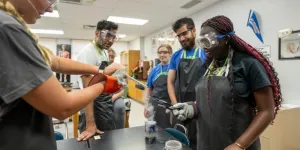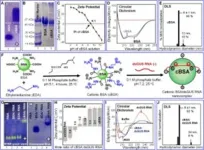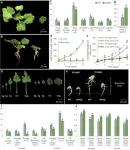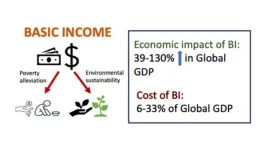(Press-News.org) In the relentless fight against cancer, a new technology promises to shed light on how we track and understand the spread of this disease within the body. A research team from Northeastern University and Dartmouth College recently developed a remarkable tool called "diffuse in vivo flow cytometry" (DiFC), which allows for the noninvasive detection and counting of rare cancer cells circulating in the bloodstream.
Monitoring cancer spread in real time
In a recent publication in the Journal of Biomedical Optics (JBO), the research team detailed their innovative two-color DiFC system, capable of simultaneously detecting two distinct populations of cancer cells in real time in small animals. This advance opens doors to a deeper understanding of cancer progression and response to treatments, as it enables researchers to study different subpopulations of cancer cells within the same animal.
Traditionally, studying circulating tumor cells (CTCs) involved invasive methods such as drawing blood samples, which often failed to capture rare CTCs or multicellular CTC clusters (CTCCs) with high metastatic potential. DiFC circumvents these limitations by using highly scattered light to probe large blood vessels, allowing for the noninvasive sampling of larger peripheral blood volumes and detection of rare cancer cells.
The team demonstrated the versatility of their two-color DiFC system through experiments involving tissue-mimicking flow phantoms and mice with multiple myeloma. By accurately differentiating between cancer cells expressing green fluorescent protein (GFP) and tdTomato, they were able to monitor the dynamics of cancer spread in real time. Notably, the majority of detected CTCCs exhibited single fluorescent proteins, providing insights into the heterogeneity of cancer cell populations.
Implications for personalized treatment
The potential implications of this technology are profound. With the ability to monitor different cancer cell subpopulations simultaneously, researchers can gain invaluable insights into tumor development and response to therapies. This helps light the way toward more targeted and personalized treatment strategies, ultimately bringing us closer to conquering cancer.
The journey towards defeating cancer is a complex one, but with advancements like DiFC, we're equipping ourselves with powerful tools to tackle this formidable foe head-on. As this technology continues to evolve, the future holds promise for more effective cancer treatments and, ultimately, a world where cancer is no longer a life-threatening diagnosis.
For details, see the original Gold Open Access article by A. Williams et al., “Two-color diffuse in vivo flow cytometer,” J. Biomed. Opt. 29(6), 065003 (2024), doi 10.1117/1.JBO.29.6.065003.
END
Advancing cancer tracking: DiFC detects rare cells noninvasively
Two-color diffuse flow cytometry unlocks insights into cancer spread
2024-06-07
ELSE PRESS RELEASES FROM THIS DATE:
nTIDE May 2024 Jobs Report: People with Disabilities Succeeding in Finding Jobs
2024-06-07
East Hanover, NJ – June 7, 2024 –May job numbers showed gains for people with disabilities, who continue to engage with the labor market at historic levels, according to today’s National Trends in Disability Employment – semi-monthly update (nTIDE), issued by Kessler Foundation and the University of New Hampshire’s Institute on Disability (UNH-IOD). Increases in both labor force participation and employment indicate that people with disabilities are not only striving to work but succeeding in finding jobs. ...
World's leading technology associations publish comprehensive curricular guidelines for computer science at the undergraduate level
2024-06-07
ACM, the Association for Computing Machinery, has joined with the IEEE Computer Society (IEEE-CS) and the Association for the Advancement of Artificial Intelligence (AAAI) to develop “Computer Science Curricula 2023” (CS2023). CS2023 provides a comprehensive guide outlining the knowledge and competencies students should attain for degrees in computer science and related disciplines at the undergraduate level.
Establishing uniform curricular guidelines for computer science disciplines is viewed as being essential to the ongoing vitality of the field and the future success of the students ...
Online professional education works for complex topics
2024-06-07
Online education is effective for teaching complicated topics like quantum information science (QIS) to high school science educators, according to a new paper by University of Texas at Arlington researchers published in The Physics Teacher.
“COVID-19 forced educators to adjust their educational best practices to an unfamiliar virtual classroom, and professional development was no different,” said Karen Jo Matsler, assistant professor in practice for UTeach at UTA and lead author on the study.
Ramon Lopez, professor of physics, was coprincipal investigator ...
Transforming agriculture: engineered nanoparticles for plant gene regulation
2024-06-07
In a major advancement for plant biology and agriculture, researchers have developed a novel method for systemic gene silencing in plants using engineered dsRNA-protein nanoparticles. This technique, which rapidly characterizes gene functions, could revolutionize in planta gene editing. The new approach addresses the longstanding challenge of transporting RNA molecules across plant cell membranes, providing a faster, non-transgenic solution for enhancing crop productivity.
Gene silencing in plants has faced significant challenges, primarily due to the difficulty of transporting RNA molecules across plant cell membranes and achieving systemic effects. Traditional genetic engineering ...
Understanding inequities in nurses’ moral distress during COVID-19
2024-06-07
Research has shown that, when nurses feel they are being prevented from taking a morally justifiable action or achieving an ethical outcome, it contributes to poor mental health, burnout, and intent to leave one’s job. Surveys from the COVID-19 pandemic found that a shortage of personal protective equipment (PPE) and lack of perceived support from hospital administrators were associated with higher levels of this moral distress.
University of Pennsylvania School of Nursing researchers and their collaborators hypothesized that nurses working in hospitals where Black patients predominantly access care—which they call Black-serving hospitals, or ...
Flavor unleashed: a scientific journey into the world of table grapes
2024-06-07
In a recent study, scientists have unlocked the secrets behind the diverse flavors of table grapes. By examining 38 different cultivars, the research offers unprecedented insights into the volatile compounds that shape our taste experiences, paving the way for enhanced grape quality and flavor.
The flavor of table grapes, influenced by various volatile compounds, plays a significant role in consumer preference and marketability. Traditional flavor analysis methods often fail to capture the complexity and diversity of grape flavors, especially in hybrid varieties. Conventional flavor classifications like muscat and foxy are insufficient for describing the wide range of flavors ...
Shrinking statures, growing insights: unraveling the genetic underpinnings of dwarfism in squash
2024-06-07
Unlocking the secrets of nature, a pioneering study has pinpointed a gene mutation with profound implications for plant height and stress tolerance. The discovery lies in the CpDWF5 gene, whose alteration leads to a compact squash plant with a unique resistance to salt stress, marking a leap forward in agricultural science.
In the quest to bolster crop yields and fortify plants against environmental stressors, the delicate interplay of phytohormones stands as a keystone. Yet, our grasp of these genetic levers, particularly those dictating plant stature and resilience to salinity, remains tenuous. Bridging ...
Fat molecule’s inability to bond with shape-shifting protein in cell’s powerhouse linked to an inherited metabolic disease
2024-06-07
FOR IMMEDIATE RELEASE
By studying mutations in yeast and human cells, Johns Hopkins Medicine scientists say they have found that biochemical bonds between fats and proteins in the mitochondrion, the cell’s powerhouse, play a crucial role in how our cells produce energy.
The study results, published June 5 in The EMBO Journal, shed new light, researchers say, on the way the altered mitochondrial membranes found in people with metabolic diseases such as Barth syndrome, a rare genetic disorder that weakens the heart, fail to enable cellular power production.
Metabolism is a set of biochemical reactions central to making energy to fuel life and to getting rid of substances a body no ...
Wildfire smoke reached 99% of U.S. lakes in 2019-2021
2024-06-07
Where there’s smoke, there’s not necessarily fire.
Wildfire smoke, sometimes drifting from hundreds of miles away, touched nearly every lake in North America for at least one day per year from 2019 to 2021, according to a study from the University of California, Davis.
Even more significantly, the study, published in the journal Global Change Biology, found that 89% of the lakes in North America experienced smoke for more than 30 days during each of those three years of intense wildfire activity.
“That was surprising, even ...
Basic income can double global GDP while reducing carbon emissions
2024-06-07
Giving a regular cash payment to the entire world population has the potential to increase global gross domestic product (GDP) by 130%, according to a new analysis published June 7 in the journal Cell Reports Sustainability. Researchers suggest that charging carbon emitters with an emission tax could help fund such basic income program while reducing environmental degradation.
“We are proposing that if we can couple basic income with environmental protection, we can save two birds with one stone,” says first author U. Rashid Sumaila of the University of British Columbia in Vancouver.
Sumaila has been working on ending harmful fishery subsidies worldwide, but many people who rely ...
LAST 30 PRESS RELEASES:
Mount Sinai Health system receives $8.5 million NIH grant renewal to advance research on long-term outcomes in children with congenital heart disease
Researchers develop treatment for advanced prostate cancer that could eliminate severe side effects
Keck Medicine of USC names Christian Pass chief financial officer
Inflatable fabric robotic arm picks apples
MD Anderson and SOPHiA GENETICS announce strategic collaboration to accelerate AI-driven precision oncology
Oil residues can travel over 5,000 miles on ocean debris, study finds
Korea University researchers discover that cholesterol-lowering drug can overcome chemotherapy resistance in triple-negative breast cancer
Ushikuvirus: A newly discovered giant virus may offer clues to the origin of life
Boosting the cell’s own cleanup
Movement matters: Light activity led to better survival in diabetes, heart, kidney disease
Method developed to identify best treatment combinations for glioblastoma based on unique cellular targets
Self-guided behavioral app helps children with epilepsy sleep earlier
Higher consumption of food preservatives is associated with an increased risk of type 2 diabetes
NTU Singapore-led team captures first-ever ‘twitch’ of the eye’s night-vision cells as they detect light, paving the way for earlier detection of blindness-causing diseases
Global aviation emissions could be halved through maximising efficiency gains, new study shows
Fewer layovers, better-connected airports, more firm growth
Exposure to natural light improves metabolic health
As we age, immune cells protect the spinal cord
New expert guidance urges caution before surgery for patients with treatment-resistant constipation
Solar hydrogen can now be produced efficiently without the scarce metal platinum
Sleeping in on weekends may help boost teens’ mental health
Study: Teens use cellphones for an hour a day at school
After more than two years of war, Palestinian children are hungry, denied education and “like the living dead”
The untold story of life with Prader-Willi syndrome - according to the siblings who live it
How the parasite that ‘gave up sex’ found more hosts – and why its victory won’t last
When is it time to jump? The boiling frog problem of AI use in physics education
Twitter data reveals partisan divide in understanding why pollen season's getting worse
AI is quick but risky for updating old software
Revolutionizing biosecurity: new multi-omics framework to transform invasive species management
From ancient herb to modern medicine: new review unveils the multi-targeted healing potential of Borago officinalis
[Press-News.org] Advancing cancer tracking: DiFC detects rare cells noninvasivelyTwo-color diffuse flow cytometry unlocks insights into cancer spread








